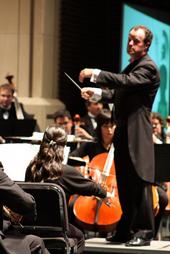Orchestra
File:Ancasta-LaViottiChamberOrchestraMozartKV136.ogv
Orchestra is a large ensemble of musicians who play together on various musical instruments. Typically, orchestras perform classical music, which includes both symphonic music and chamber music, but they can also play a variety of other music genres. The term "orchestra" originally derived from the Greek orchestra, a name for the area in front of a stage in ancient Greek theaters where the chorus would perform. Over time, the term came to refer to the group of musicians themselves.
Composition[edit | edit source]
An orchestra is typically divided into four main sections: the string section, the woodwind section, the brass section, and the percussion section. Each section contains a variety of instruments.
String Section[edit | edit source]
The string section is the largest part of the orchestra and usually includes violins, violas, cellos, and double basses. The violins are often divided into two groups: first violins and second violins, with the first violins playing the melody more often and the second violins playing harmony.
Woodwind Section[edit | edit source]
The woodwind section typically includes flutes, oboes, clarinets, and bassoons. Some orchestras also incorporate additional woodwind instruments such as the piccolo, English horn, bass clarinet, and contrabassoon.
Brass Section[edit | edit source]
The brass section consists of trumpets, French horns, trombones, and tubas. The specific number and type of brass instruments can vary depending on the piece being performed.
Percussion Section[edit | edit source]
The percussion section includes a wide range of instruments, such as timpani, snare drum, bass drum, cymbals, and xylophone. Some pieces also call for more exotic percussion instruments like the glockenspiel or marimba.
Conductor[edit | edit source]
The conductor leads the orchestra, shaping the sound of the ensemble and ensuring that all musicians play together in harmony and with the correct timing. The conductor uses a baton to beat time and uses hand gestures to communicate desired musical expressions.
Repertoire[edit | edit source]
Orchestras perform a wide range of music, from Baroque and Classical works to contemporary pieces. The repertoire of an orchestra can include symphonies, concertos, overtures, and suites. Many orchestras also engage in performances of opera and ballet music.
Types of Orchestras[edit | edit source]
There are several types of orchestras, including symphony orchestras, chamber orchestras, and philharmonic orchestras. Symphony orchestras are large and can include over a hundred musicians, while chamber orchestras are smaller and more intimate. Philharmonic orchestras are similar to symphony orchestras in size and repertoire, and the terms are often used interchangeably, though "philharmonic" simply means "loving harmony."
History[edit | edit source]
The orchestra as we know it today evolved during the late Renaissance and early Baroque periods, with significant developments occurring during the Classical and Romantic eras. The size and composition of the orchestra expanded over time, and the role of the conductor became more defined.
Education and Outreach[edit | edit source]
Many orchestras engage in educational and outreach programs to introduce children and adults to classical music. These programs may include school concerts, open rehearsals, and instrument petting zoos, where participants can try out different orchestral instruments.
Challenges and Future[edit | edit source]
Orchestras face various challenges, including financial pressures, audience development, and the need to remain relevant in a rapidly changing cultural landscape. Many orchestras are exploring new concert formats, repertoire, and ways to engage with their communities to ensure their future sustainability.
Search WikiMD
Ad.Tired of being Overweight? Try W8MD's NYC physician weight loss.
Semaglutide (Ozempic / Wegovy and Tirzepatide (Mounjaro / Zepbound) available. Call 718 946 5500.
Advertise on WikiMD
|
WikiMD's Wellness Encyclopedia |
| Let Food Be Thy Medicine Medicine Thy Food - Hippocrates |
Translate this page: - East Asian
中文,
日本,
한국어,
South Asian
हिन्दी,
தமிழ்,
తెలుగు,
Urdu,
ಕನ್ನಡ,
Southeast Asian
Indonesian,
Vietnamese,
Thai,
မြန်မာဘာသာ,
বাংলা
European
español,
Deutsch,
français,
Greek,
português do Brasil,
polski,
română,
русский,
Nederlands,
norsk,
svenska,
suomi,
Italian
Middle Eastern & African
عربى,
Turkish,
Persian,
Hebrew,
Afrikaans,
isiZulu,
Kiswahili,
Other
Bulgarian,
Hungarian,
Czech,
Swedish,
മലയാളം,
मराठी,
ਪੰਜਾਬੀ,
ગુજરાતી,
Portuguese,
Ukrainian
Medical Disclaimer: WikiMD is not a substitute for professional medical advice. The information on WikiMD is provided as an information resource only, may be incorrect, outdated or misleading, and is not to be used or relied on for any diagnostic or treatment purposes. Please consult your health care provider before making any healthcare decisions or for guidance about a specific medical condition. WikiMD expressly disclaims responsibility, and shall have no liability, for any damages, loss, injury, or liability whatsoever suffered as a result of your reliance on the information contained in this site. By visiting this site you agree to the foregoing terms and conditions, which may from time to time be changed or supplemented by WikiMD. If you do not agree to the foregoing terms and conditions, you should not enter or use this site. See full disclaimer.
Credits:Most images are courtesy of Wikimedia commons, and templates, categories Wikipedia, licensed under CC BY SA or similar.
Contributors: Prab R. Tumpati, MD





